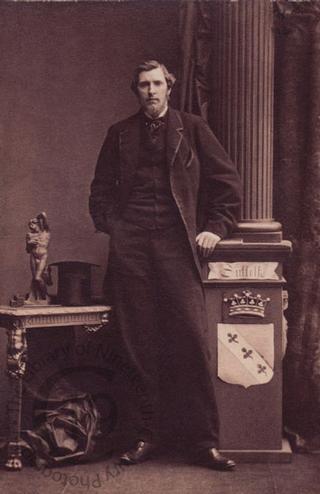
Marquess of Bristol
A carte-de-visite portrait of the 3rd Marquess of Bristol.
Born on 28 June 1834 at Bristol House on Putney Heath, Frederick William John Hervey was the eldest son of Frederick Hervey, later the 2nd Marquess of Bristol. His mother was Lady Katherine Isabella née Manners, daughter of John Manners, 5th Duke of Rutland. He was styled Lord Hervey from birth until his father was raised to the marquessate in 1859; after that he was styled Earl Jermyn until he succeeded to his titles and estates in 1864. For those last five years, he was the Member of Parliament in the Conservative interest for West Suffolk.
Educated at Eton and at Trinity College, Cambridge, he graduated with an MA in 1856. From 1854 he served in the 3rd Battalion of the Suffolk militia; in 1865 he became his regiment’s Honorary Colonel. On 4 March 1862, he married Geraldine Georgiana Mary Anson, a daughter of General the Honourable George Anson. Their marriage produced two daughters.
His principal residence was the neoclassical Ickworth House near Bury St Edmunds in Suffolk. There he commissioned a Pompeian Room, with designs based on wall paintings discovered in 1777 at the Villa Negroni on the Esquiline Hill in Rome.
Lord Bristol died, aged 73, at Ickworth House on 7 August 1907. ‘He took a chill about Easter last, from which he never thoroughly rallied, and complications arose, resulting in his death’ (The Globe, 7 August 1907).
According to his obituary in the Westminster Gazette (7 August 1907): ‘Lord Bristol was a man of fine presence, till quite lately a regular attendant in the House of Lords, and well known in London society. He was a staunch Conservative and devoted Churchman, who took much interest in the scheme for a Suffolk bishopric. He was a very clubbable man, belonging to the Carlton, Travellers’, Boodle’s, White’s, and the Naval and Military. His all-round knowledge of men and affairs, and of various aspects of life, made him a capital companion, and he was one who got through an immense amount of work, being a master of detail, a man of broad sympathies, and excessive kindness of heart.’
Photographed by Camille Silvy of London on 23 February 1861.
Code: 124718




